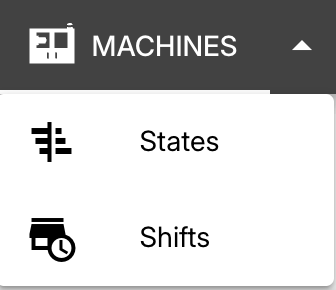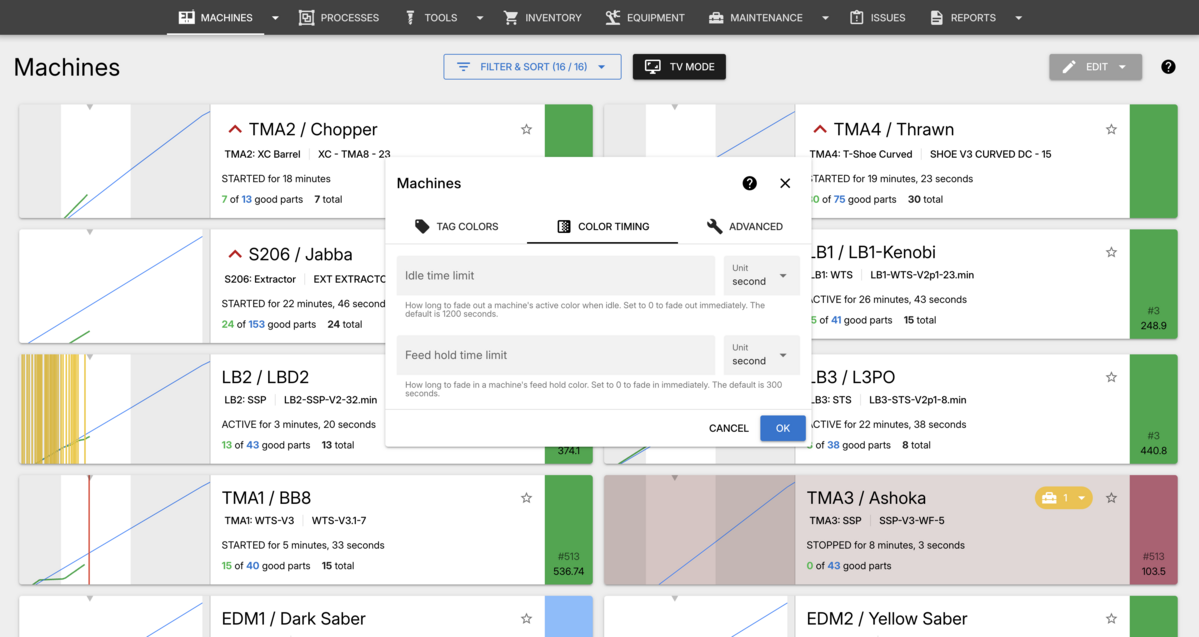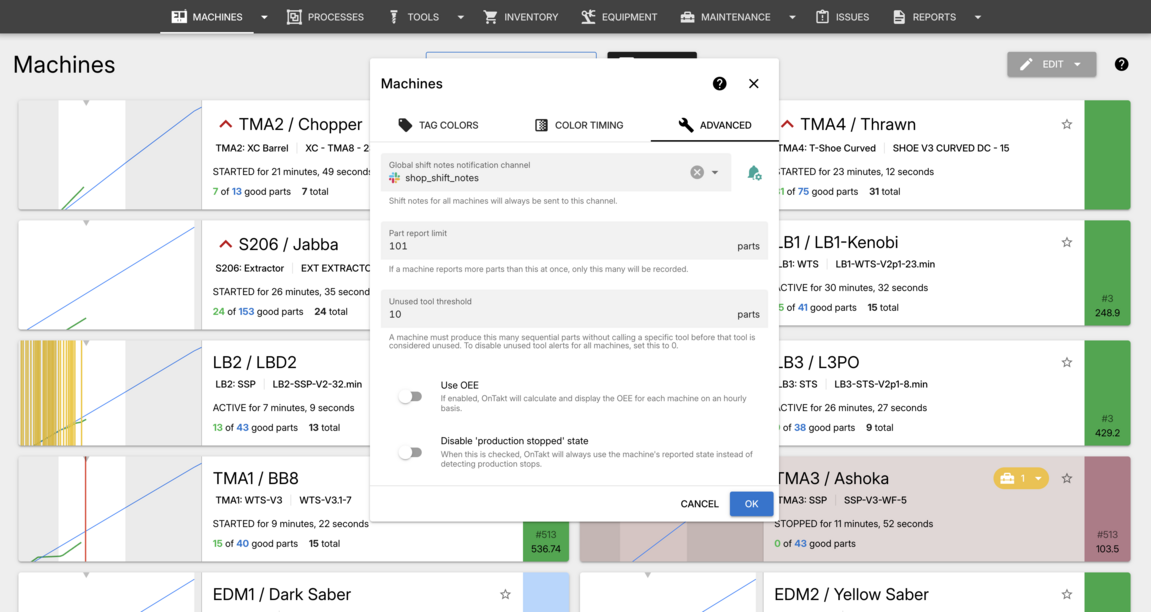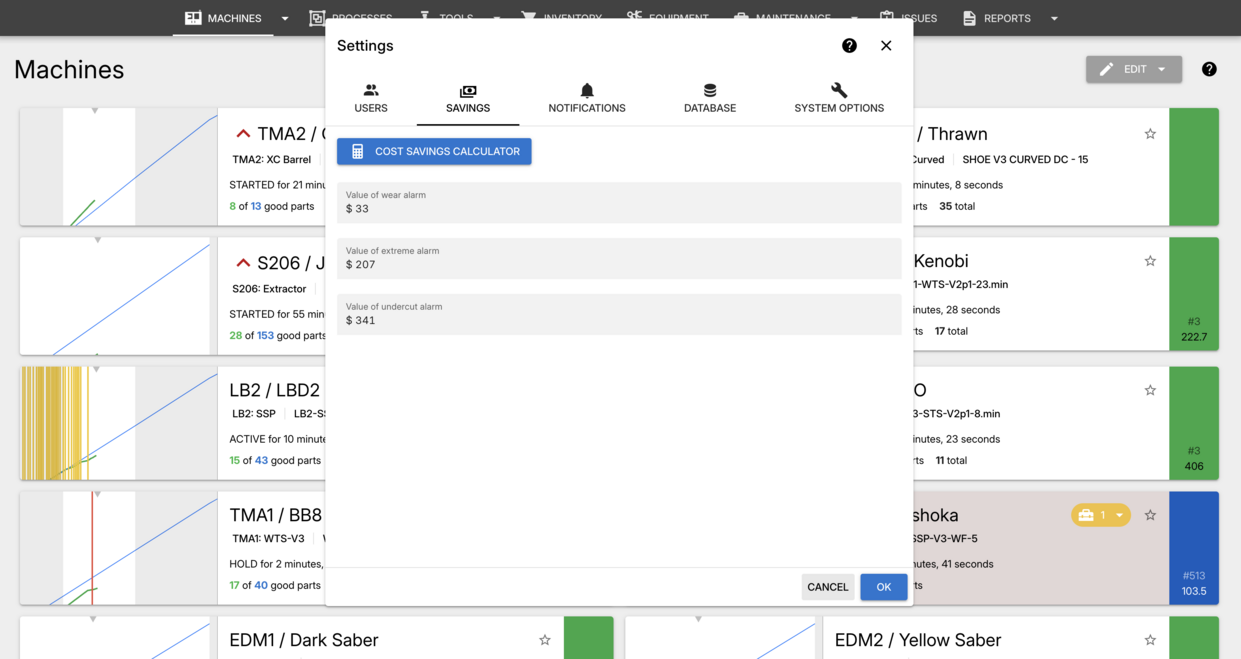Part of the OnTakt User Guide.
The settings window allows administrators to change how OnTakt behaves.
Machine settings
Defining shift times
Shift times are used to calculate daily goals for part production. If they are not set up correctly, daily goal lines will not be drawn or they will be drawn inaccurately. Shift times can also be overridden on a per-machine basis. Be sure the time zone (also available from the Options page) is set correctly before defining shift times. Once the time zone is set, click Save Changes before defining shift times.
To set shift times:
- Click the drop down arrow located to the right of the "MACHINES" module, select "Shifts"
- In the bottom right hand corner, click the green "+NEW" button
- Configure the shift info (color, name, start and end time, days that the shift applies to, and whether the shift is unattended)
- Click on "Machines" and add the machines that adhere by those shifts. Clicking exit will save the settings.
Color timing
Color timing can be configured by clicking the "Edit" button in the top right hand corner of the screen, and click on "Settings"
- Idle time limit: How long to fade out a machine's active color when idle. Set to 0 to fade out immediately. The default is 1200 seconds.
- Feed hold time limit: How long to fade in a machine's feed hold color. Set to 0 to fade in immediately. The default is 300 seconds.
Advanced machine settings
Part report limit
If a machine reports more than this number of parts at once, only one part will be created.
This prevents overloading the server in cases where program errors cause the machine to report the part count incorrectly.
Cost savings estimation
How much money is TMAC saving you?
Use the Calculator button to determine the values for these fields.
- In the calculator window, enter how much each event listed would cost you, as well as how frequently it happens. Click "Save calculations" to save your work for later and automatically copy the calculated totals into the alarm value fields.
- For frequency, 1 means it always happens, 0 means it never happens, 0.5 means it happens in half of cycles, etc.
- These values will be shown in reports based on how frequently TMAC alarms occur.
User management
- To manage users: click on current profile in the top right of the screen, click on "Global Settings", and navigate to the Users Tab. Click "Add" and set the username, password, active status, access level, kudos emoji,
- To change a user's password: click the Edit button next to that user and enter a new password.
- To prevent a user from logging in without deleting their account: switch off the Active option in the user editor.
Access levels
The following table shows the permissions associated with each profile.
| Administrator | Planner | Shop Team | Auditor | |
|---|---|---|---|---|
| Alerts (Certain alert-dependent actions may not be available to all users) | ||||
| View alerts | ✓ | ✓ | ✓ | ✓ |
| Perform system check | ✓ | ✓ | ✓ | ✓ |
| Dismiss alerts | ✓ | ✓ | ✓ | |
| Clear all alerts | ✓ | ✓ | ||
| Machines | ||||
| View/chart machines | ✓ | ✓ | ✓ | ✓ |
| Modify basic machine options | ✓ | ✓ | ||
| Submit machine state updates | ✓ | ✓ | ||
| Create machines | ✓ | |||
| Modify machine system options | ✓ | |||
| Programs | ||||
| View/chart programs and processes | ✓ | ✓ | ✓ | ✓ |
| Perform process changeovers | ✓ | ✓ | ✓ | |
| Edit/delete programs and processes | ✓ | ✓ | ||
| Tools | ||||
| View tools | ✓ | ✓ | ✓ | ✓ |
| View tool assignments | ✓ | ✓ | ✓ | ✓ |
| Replace tools | ✓ | ✓ | ✓ | |
| Create tools | ✓ | ✓ | ||
| Edit tools | ✓ | ✓ | ||
| Delete tools | ✓ | ✓ | ||
| Add tools to tool assemblies | ✓ | ✓ | ||
| Assign tool assemblies to processes | ✓ | ✓ | ||
| Parts | ||||
| View/chart parts | ✓ | ✓ | ✓ | ✓ |
| Edit parts | ✓ | ✓ | ✓ | |
| Delete parts | ✓ | ✓ | ✓ | |
| Edit or delete parts in bulk | ✓ | ✓ | ||
| Edit events | ✓ | ✓ | ✓ | |
| Delete events | ✓ | ✓ | ||
| Quality | ||||
| View/chart AutoComp data | ✓ | ✓ | ✓ | ✓ |
| Reports | ||||
| Generate reports | ✓ | ✓ | ✓ | ✓ |
| Options | ||||
| Modify options | ✓ | ✓ | ||
| Change passwords | ✓ | |||
| View plugin logs | ✓ | ✓ | ✓ | ✓ |
| Install and uninstall plugins | ✓ | |||
Time zone
A production day as displayed on charts will be defined in this time zone. It is also used for server-side time-based events such as notifications and reports. Except where otherwise specified, times are displayed in the browser's local time zone regardless of this setting.
Changing the time zone affects the server's time-based actions, such as sending midnight notifications. Times displayed in the web interface will always be shown in the time zone of the client device (computer, phone, etc.).
Times are stored in the database using UTC, so changing the time zone will not change any other database entries, such as part or event times.
Steps to select time zone:
- Click on the profile name in the top right hand corner of the screen, select "global settings"
- Go to the "System Options" tab, chose the desired time zone
Notification setup
See Notification setup for help connecting to external services.
Trash
The trashed objects list is part of the Audit Log.
Database
Downloaded files are PostgreSQL dumps that can be loaded using pg_restore.
For example, to convert a backup named ontakt_db.dump to a plain text SQL file named ontakt_db.sql, run pg_restore -f ontakt_db.sql ontakt_db.dump.





